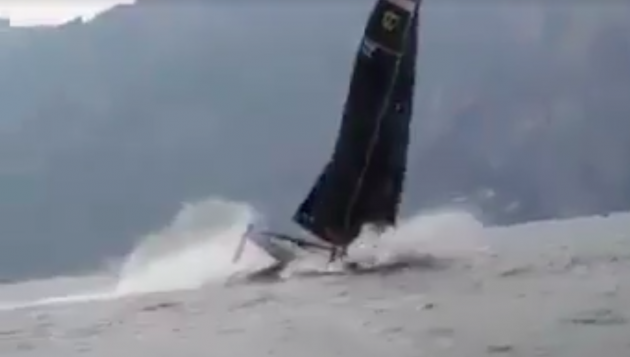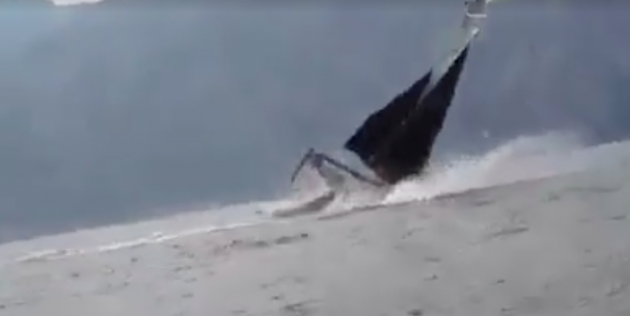A safety group has been set up after a GC32 foiling catamaran helmed by Prince Casiraghi of Monaco collided at high speed this weekend with a photographer’s RIB
A high speed crash on Lake Garda this weekend between a GC32 foiling catamaran and a photographer’s RIB left both boats damaged but fortunately no-one injured. The catamaran Malizia Yacht Club de Monaco was being helmed by Prince Casiraghi of Monaco and was foiling downwind at over 20 knots when it appeared to run into RIB being used by Italian photographer Carlo Borlenghi.
Following the incident, there have been arguments about who is to liable for the collision and the GC32 Class Association has set up a safety group to investigate how such accidents can be prevented in future.
The GC32 Tour runs at several venues in Italy and Spain during the summer. This event was being held at Malcesine on Lake Garda. The GC Tour now has ten boats, the same kind of foiling multihulls that have been adopted by the Extreme Sailing Series. But this is a bigger fleet.
The accident follows other serious collisions between high speed multihulls and chase boats or marshall boats. The most serious to date was between the giant trimaran Spindrift and a marshall boat at the start a Volvo Ocean Race leg in Lorient in 2015 when a woman’s leg was struck and severed by the yacht’s daggerboard foil.
I took part as a guest racer in the first of the Malescine Cup races last week and was struck by how frightening the racing could be at times. From a reaching start at over 30 knots – these boats have topped out at 39 knots – the ten boats were at times hair-raisingly close.
What is perhaps not apparent from looking at such foiling boats from a distance is that they hunt around considerably while up on foils. Getting foiling is relatively easy, as once at 14 knots boat speed these boats pop up on the leeward foils.
The knack is to stay foiling for as long as possible, and for this crews need to keep the apparent wind high enough. This means a certain amount of weaving around for it, so these boats do not follow a straight line course, as monohulls would do.
This can make their progress unpredictable. At times during our race in 18 knots of wind, boats came scarily close. As I tightened my white-knuckle grip on the trampoline, I thought: one miscalculation by the helmsman in such a large fleet and there would be a high-speed accident.
At one point we also came very close to two photographers’ RIBs, one of which was towing a large inflatable balloon carrying video equipment. There was no way the photographer could pull this out of the way in time, so our helmsman had to bear away slightly and dodge it.
The remedies to prevent future accidents may include protected areas or better raining. Either the rules will reflect the fact that even some of the most high powered RIBs cannot accelerate fast enough to back or drive out of trouble. Or the boats themselves may be adapted or developed for this style of racing.
The latter possibility was something mentioned to me last week by Luca Rizzotti, the organiser of The Foiling Week. Although not directly involved with the GC32 Tour, he observes that press and chase boats in future need similar power and agility to the sailing yachts themselves. “Perhaps they should also be foiling boats,” he commented.

Screenshots from a video of the incident. The yacht is approaching the rib.

Screenshots from a video of the incident. You can see them make contact.

Screenshots from a video of the incident. The rib appears to be underneath the yacht.

Screenshots from a video of the incident. The yacht starts to nosedive

Screenshots from a video of the incident. Over she goes.



